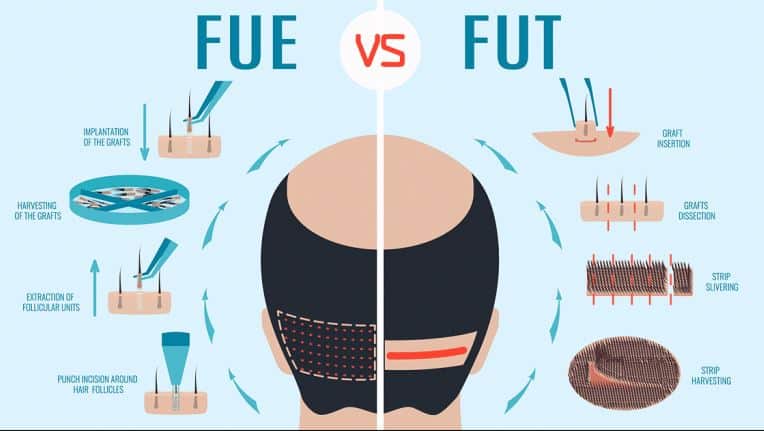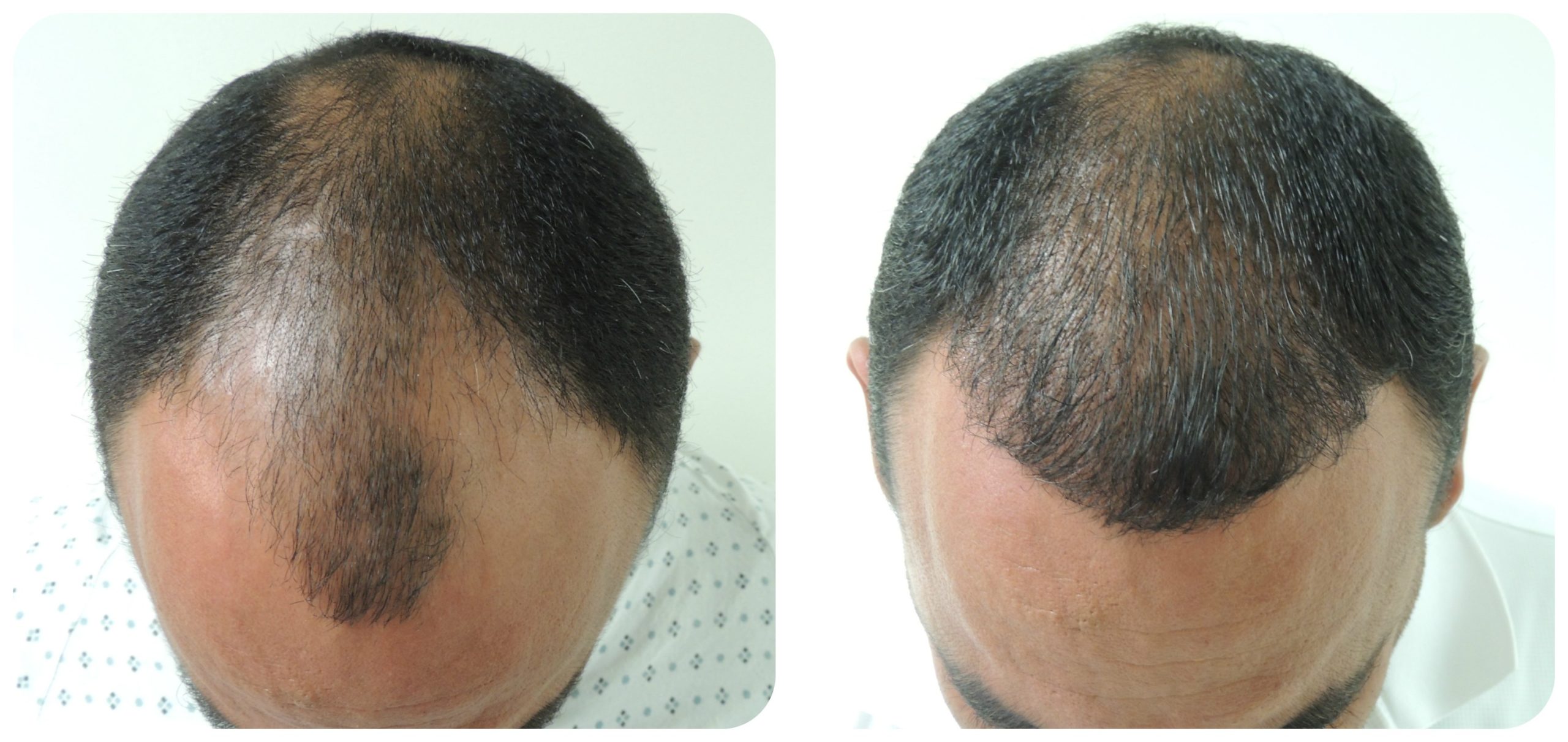Hair Transplant Types: FUE, FUT, and the Complete Guide to All of Your Options
Hair transplant procedures have come a long way in recent years, with impressive, natural-looking results that last.
They’ve also become less of a taboo, with more people being open about the fact that they’ve had a hair transplant. Some well-known names who’ve admitted to having hair transplants include Wayne Rooney, Joe Swash, and Gordon Ramsay. Additionally, there are also many celebrities who are rumored to have had a hair transplant, including Jude Law, John Travolta, and Hugh Laurie.
Like other cosmetic procedures, choosing to have a hair transplant can help boost your self-esteem, restoring a natural appearance and the confidence you once had. But as with any procedure, it’s important that you understand the ins and outs of hair transplants.
By learning more about hair loss and the procedures are available to treat this condition, you can be better equipped to decide the best route for you.
Jump to a section:
- The causes of male-pattern hair loss
- What are the different types of hair transplants?
- Common questions about hair transplants
- What are the alternatives to transplants?
- About hair loss shampoos and supplements
The causes of male-pattern hair loss – why do hair follicles stop growing hair?
Male-pattern hair loss is experienced by around a third of men, with signs usually appearing by the age of 30. Some studies claim that male-pattern hair loss affects as many as 42% of men, with frontal baldness, in particular, being more common than previously thought.
Your hair grows from underneath the skin, with hairs shedding roughly every 3-5 years. After a hair has shed, a new one will grow from the hair follicle – a process that repeats itself.
Dihydrotestosterone (DHT) is a type of testosterone that when produced, can damage hair follicles, meaning that new hairs come back thinner and more fragile, leading to noticeable thinning areas and eventual hair loss. It’s important to point out that not everyone is susceptible to DHT since it depends on your genes. Once you experience male-pattern hair loss, however, it will continue to progress.
What are the different types of hair transplants? FUE vs FUT Transplantation
There are two main types of hair transplant surgeries for treating male-pattern baldness: Follicular Unit Extraction (FUE) and Follicular Unit Transplantation (FUT). Both the FUT procedure and FUE procedure work by taking hairs from the back and sides of the head and moving them to the areas where there is hair loss. Some people have also successfully used chest and beard hair for the procedure.


Follicular Unit Extraction (FUE) is performed by using a small punch to cut individual hair follicles, removing the entire graft. An FUE procedure can either be done manually or by using a robotic device, depending on the surgeon’s preferred implantation process. FUE hair transplantation can cause scarring, and it might take multiple procedures to gather the number of hair grafts required. Many people prefer FUE hair transplants, however, as they are less invasive than FUT transplants and could provide more flexibility when it comes to hairstyling in the future, making shorter hairstyles possible. Hair will most likely need to be shaved for the FUE procedure, which is important to bear in mind.
Follicular Unit Transplantation (FUT), meanwhile, involves the removal of a linear ellipse-shaped incision. An FUT hair transplant makes it possible to acquire a large number of grafts in one procedure, without the need for shaving. The wounds left behind during an FUT procedure are typically stapled closed and can leave linear scarring – although this can be covered by the surrounding hair.
Which Hair Transplant Method is Best?
While in both surgical methods, the procedure for acquiring the grafts differs, the FUT procedure is more straightforward. The surgeon will place the donor hair grafts in the recipient site where they are most needed to ensure the most natural-looking coverage and a fuller head of hair. This is done by making incisions in the scalp and directly inserting the grafts manually. Other methods include using tools that create the incisions and transplant the grafts at the same time. It can take up to 8-10 hours to complete the procedure.
With surgical hair transplants, it can take 3-4 months for new hair growth to begin. All new hairs should be growing 8 months after the procedure, and it can take up to 18 months for the transplanted hair to reach maturity.
Common questions about hair transplants
Surgical hair transplants can produce incredible results, but it’s understandable if you have some questions about the procedure to help you decide if it’s right for you. Some of the most common questions about hair transplantation include:
Does it hurt?
The procedure itself doesn’t hurt as a local anesthetic is used. However, patients can experience discomfort following the procedure, especially with FUT hair transplants. Most symptoms of pain or discomfort can be eased with painkillers.
Will I have scars from hair transplant surgery?
Of the two types of surgical hair restoration, follicular unit extraction is less likely to lead to scarring, making it the preferred option for short hair. However, scars caused by follicular unit transportation can be hidden with longer hair.
How long does the hair transplant procedure take?
Hair transplantation takes around 8 hours to complete. The recovery process can take several weeks and will be quite visible, which is why many people decide to take some leave following the procedure.
What is the cost of a hair transplant?
Hair transplant cost varies depending on the scale of the procedure. It typically ranges from $5,000 – $12,000. FUT can be cheaper as it’s possible to acquire all of the grafts needed in one sitting, shortening the length of the process.
When will I see hair growth results?
Hair transplant results usually appear within 3-4 months, with full results visible around the 12-month mark.
Am I suitable for a hair transplant?
To stand the best chance of hair restoration success, a candidate will need to have hair to transplant. The more healthy hair you have, the better the chance of success. A consultation will help establish whether or not a transplant is right for you.
Is a hair transplant permanent?
A transplant should last a very long time, although there are no guarantees that it is permanent. Hairs might react differently to how they would from the donor site.
How successful are hair transplants?
Many people are satisfied with their hair transplant results, but they do depend on the quality of the available donor hairs and other personal factors. It’s important to determine with your surgeon if you’re an appropriate candidate. The surgeon can also help you anticipate what the likely final outcome will be. In some very rare cases, hair follicles can be rejected.


Are there risks?
As with any type of surgery, hair transplantation has some mild risks attached. Some of the effects include bleeding and bruising, and some cysts can form on the transplant area during the recovery process. However, these complications are easily treatable. Choosing a reputable surgeon is vital for a hair transplant to ensure you are in safe hands. Your surgeon will discuss possible risks with you before you decide to go ahead with the procedure.
How do I find a hair transplant surgeon?
Finding a reputable surgeon is vital to having a successful hair transplant. While some sites can offer the procedure at extremely cheap prices, it’s important to choose a qualified and certified surgeon. You should look for a plastic surgeon with specific experience in hair transplants, preferably someone who can show you pictures of their past patients. At VIDA Wellness and Beauty, we only work with experienced and board-certified surgeons, experts in hair restoration techniques.
What are the alternatives to transplants?
While transplants are becoming a popular choice for combating baldness, there are alternative treatments that can help. Some common medications include:
Minoxidil
Sold over-the-counter through brands like Regaine, minoxidil works by penetrating the hair follicles and rejuvenating them to help them produce stronger hairs and extend the hair growth process.
Finasteride
Sold through brands such as Propecia, finasteride is a prescription-based medication that aims to block DHT, preventing it from damaging the follicles that cause thinning hair. Depending on your insurance, you might be able to get finasteride as a free prescription, or you will need to pay for it at your local pharmacy.
About hair loss shampoos and supplements
Hair loss shampoos are marketed as a way to treat male-pattern baldness or thinning hair, but unfortunately, these are bold claims that won’t provide the results expected. At best, they will help thicken your hair, although the process is temporary.
Supplements work in the same way, and while they could work to strengthen the hair that’s left, they will only be effective in those with a mineral deficiency, which is something that should be discussed with a doctor anyway.
Despite the gimmicks and expensive labels, these types of hair loss treatments are likely to be ineffective when it comes to treating hair loss.
There are also a lot of old wives’ tales about reducing hair loss, including applying aloe vera or coconut milk. Again, these sorts of methods have no substance for treating hair loss and will end up being a waste of time and money.
For the most effective results to combat male-pattern hair loss, a hair transplant is the best solution. Technology and surgical practices have come a long way since the hair plugs of the 1980s and can produce natural, impressive results that last. With more and more people embracing transplants, it could be the ideal solution to restore your hair and your confidence. Contact VIDA Wellness and Beauty at (619) 738-2144 and schedule a free consultation with a certified plastic surgeon to discuss your hair restoration options.